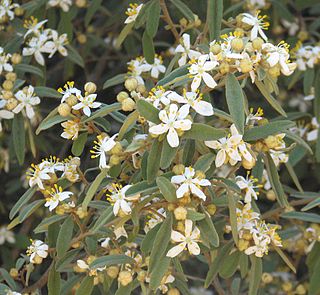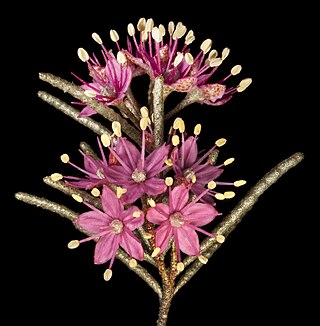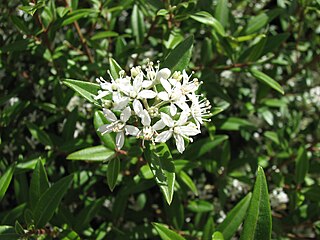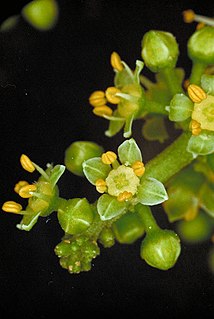
Correa is a genus of eleven species of flowering plants in the family Rutaceae that are endemic to Australia. Plants in the genus Correa are shrubs to small trees with simple leaves arranged in opposite pairs, bisexual flowers with four sepals, four petals usually fused for most of their length and eight stamens.

Melicope is a genus of about 240 species of shrubs and trees in the family Rutaceae, occurring from the Hawaiian Islands across the Pacific Ocean to tropical Asia, Australia and New Zealand. Plants in the genus Melicope have simple or trifoliate leaves arranged in opposite pairs, flowers arranged in panicles, with four sepals, four petals and four or eight stamens and fruit composed of up to four follicles.

Angophora is a genus of nine species of trees and shrubs in the myrtle family, Myrtaceae. Endemic to eastern Australia, they differ from other eucalypts in having juvenile and adult leaves arranged in opposite pairs, sepals reduced to projections on the edge of the floral cup, four or five overlapping, more or less round petals, and a papery or thin, woody, often strongly ribbed capsule. Species are found between the Atherton Tableland in Queensland and south through New South Wales to eastern Victoria, Australia.

Flindersia is a genus of 17 species of small to large trees in the family Rutaceae. They have simple or pinnate leaves, flowers arranged in panicles at or near the ends of branchlets and fruit that is a woody capsule containing winged seeds. They grow naturally in Australia, the Moluccas, New Guinea and New Caledonia.

Bosistoa is a genus of four species of tree in the family Rutaceae endemic to eastern Australia. They have simple or compound leaves arranged in opposite pairs and bisexual flowers arranged in panicles, each flower with five sepals, five white petals and ten stamens.

Geijera is a genus of shrubs and trees in the family Rutaceae and are native to New Guinea, Australia and New Caledonia. They have simple leaves arranged alternately, panicles of bisexual flowers usually with five, sometimes four, sepals, petals and stamens and fruit containing shiny black seeds.

Acronychia is a genus of about fifty species of plants in the rue family Rutaceae. The leaves are simple or pinnate, and the flowers bisexual with four sepals, four petals and eight stamens. They have a broad distribution including in India, Malesia, Australia and the islands of the western Pacific Ocean. About twenty species are endemic to Australia.

Asterolasia is a genus of seventeen species of erect or prostrate shrubs in the family Rutaceae, and is endemic to Australia. The leaves are simple and arranged alternately, the flowers arranged in umbel-like groups on the ends of branchlets or in leaf axils, usually with five sepals, five petals and ten to twenty-five stamens. There are seventeen species and they are found in all Australian mainland states but not in the Northern Territory.

Phebalium is a genus of thirty species of shrubs or small trees in the family Rutaceae and is endemic to Australia. The leaves are arranged alternately, simple and often warty, the flowers arranged singly or in umbels on the ends of branchlets or in leaf axils, usually with five sepals, five petals and ten stamens. There are about thirty species and they are found in all Australian states but not in the Northern Territory.

Sarcomelicope is a genus of about ten species of flowering plants in the family Rutaceae that are endemic to the South Pacific.

Acradenia is a genus of two species of tree or shrub in the family Rutaceae and is endemic to Australia. These plants have leaves that are trifoliate, arranged in opposite pairs and flowers that have five sepals, five petals and usually ten stamens of unequal lengths.

Nematolepis is a genus of seven species of plants in the family Rutaceae, all endemic to Australia. They are shrubs or small trees with more or less flat leaves arranged alternately and flowers with five overlapping petals and ten stamens. Six species are found in eastern Australia and one in Western Australia.

Acronychia laevis, commonly known as hard aspen, glossy acronychia or northern white lilly pilly, is a species of shrub or small tree in the citrus family, and is endemic to eastern Australia. It has simple, elliptical to egg-shaped leaves, groups of creamy white flowers and fleshy, mitre-shaped to spherical fruit.

Bouchardatia is a genus of two species of tree in the family Rutaceae, one species endemic to eastern Australia, the other to New Guinea. They have compound leaves with three or five leaflets, and are arranged in opposite pairs. The flowers are bisexual, arranged in panicles, each flower with four sepals, four petals and eight stamens, the petals and stamens all free from each other. The fruit has up to four ridged follicles fused at the base, each containing a single seed.
Medicosma elliptica, commonly known as Bulburin medicosma, is a species of shrub or small tree in the family Rutaceae and is endemic to a restricted area of Queensland. It has elliptical leaves and white flowers borne singly or in small groups in leaf axils.

Medicosma fareana, commonly known as white aspen, is a species of rainforest small tree in the family Rutaceae and is endemic to north Queensland. It has elliptical leaves and white or cream-coloured flowers borne singly or in small groups in leaf axils.
Medicosma obovata is a species of shrub or small tree in the family Rutaceae and is endemic to a restricted area of far north Queensland. It has simple egg-shaped leaves with the narrower end towards the base and white flowers borne singly or in small groups in leaf axils.

Medicosma sessiliflora is a species of shrub or small tree in the family Rutaceae and is endemic to far north Queensland. It has simple elliptical to egg-shaped leaves with the narrower end towards the base and cream-coloured flowers borne singly or in small groups in leaf axils.
Melicope affinis is a species of shrub or tree in the family Rutaceae and is endemic to Queensland. It has trifoliate leaves and small greenish white flowers borne in panicles in leaf axils.

Melicope xanthoxyloides is a species of small tree in the family Rutaceae and is native to New Guinea and Queensland. It has trifoliate leaves and small green to yellow or cream-coloured flowers arranged in panicles in leaf axils.

















